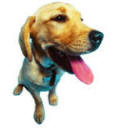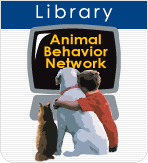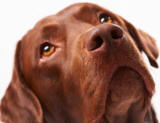|
Need Help?
|
|
Call
1-800-372-3706
to
speak to a Veterinary Behavior Technician |
|
Paws To Speak!
Member
Main Menu
|
|

Pet Forbidden
Areas

Don't leave your dog
Home Alone!
Ask
your veterinarian about
Dog Daycare Programs
.jpg)
|
 |
|
Help is at your
fingertips by library, email and
phone. |

Click on
Library Icon
to learn more
|
If
this is wrong, what is right?
The key to dog proofing your home is to
remove temptation while teaching the dog with lots
of praise what items you are providing to satisfy
this natural exploration and chewing behavior. Think
of your dog asking you this question in regards to
chewing, "If this is wrong, what is right?"
Any dog in the process of exploring can eat or
damage inappropriate objects. Young dogs are especially
curious! If your dog is curious, allow less freedom in the
house and make sure you are there to supervise all
activity.
Your dog needs to learn
to focus his or her active mind and desire to chew on the right things.
Why do dogs destroy household items?
Dogs are
especially curious during their critical learning
period from 1 month to 3 months of age. They explore
the world with their mouths which can lead to
destruction of household items. Dog teeth begin to
fall out at 4 months of age with adult teeth
replacing them in the months ahead. Teething is
another reason dogs like to chew.
.jpg)
It's a good idea to remove children's toys from the
floor, especially those that may have been touched
by sticky fingers that previously had food on them.
Locate all electrical cords in your house. They are
often searched for and chewed on by dogs because of
their interesting consistency. Hide the electrical
cords under carpeting, or place in a protective
casing from a material like PVC. If this is too much
trouble or not practical, coat cords with a bitter
tasting material available from the pet store, or
remove them if that's an option.
|
The overall strategy is to
supervise the dog as they
explore the home.
Praise the dog frequently
for acting appropriately and
be close by at all times to
interrupt any mistakes. |
It's best to remove
any plants that the dog might be able to get into
and put them out of the way, until the dog can be
trusted not to chew or destroy them. If you are
dealing with an adult dog, beware - the tail is
often sweeping and may sweep materials off coffee
tables and other low surfaces, so you may want to
remove these items.
What if I don't want to dog
proof my home?
Clear or block
access to any furniture that has
a leather or food-stained
surface as these may attract
chewing. It's generally not
advised to allow dogs on
furniture without permission,
especially if these items have
pillows or wood corners that may
attract chewing.
To make furniture unattractive
to the dog during this training phase, you can do a variety of strategies.
Consider placing a plastic carpet runner, spike side up or placing a stack
of empty cans with pennies taped
inside to create noise if
disturbed. Think outside the
box. What can you do that will
make the couch unattractive to
the dog that will not harm the
dog in anyway.
The key to teaching good
behavior is to think about what
you want the dog to do from the
dog's point of view. Ask
yourself, what can I do to make
it in the dog's best interest to
do what I want and to learn the
house rules?
|